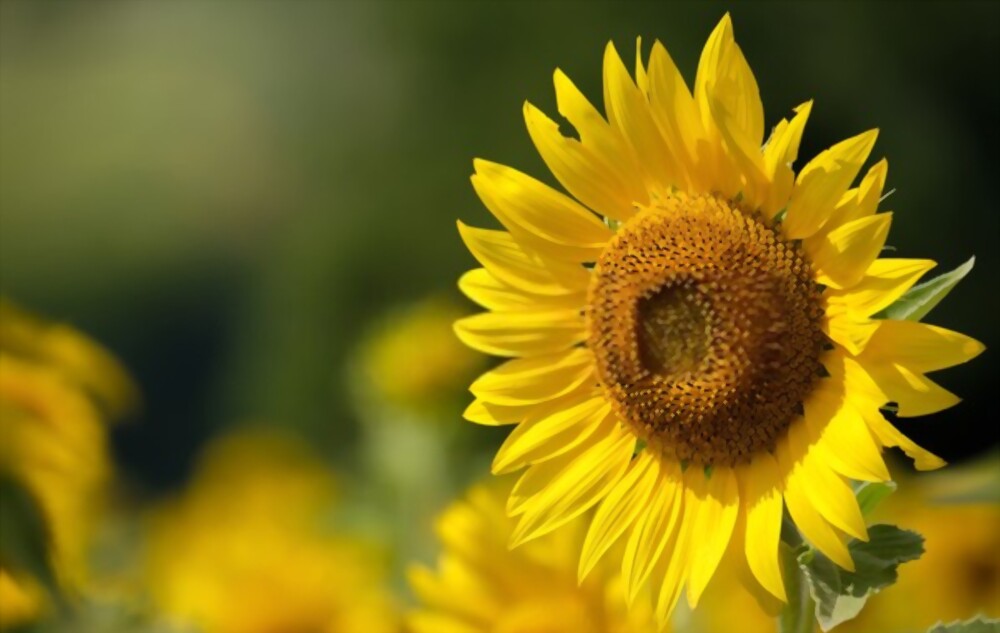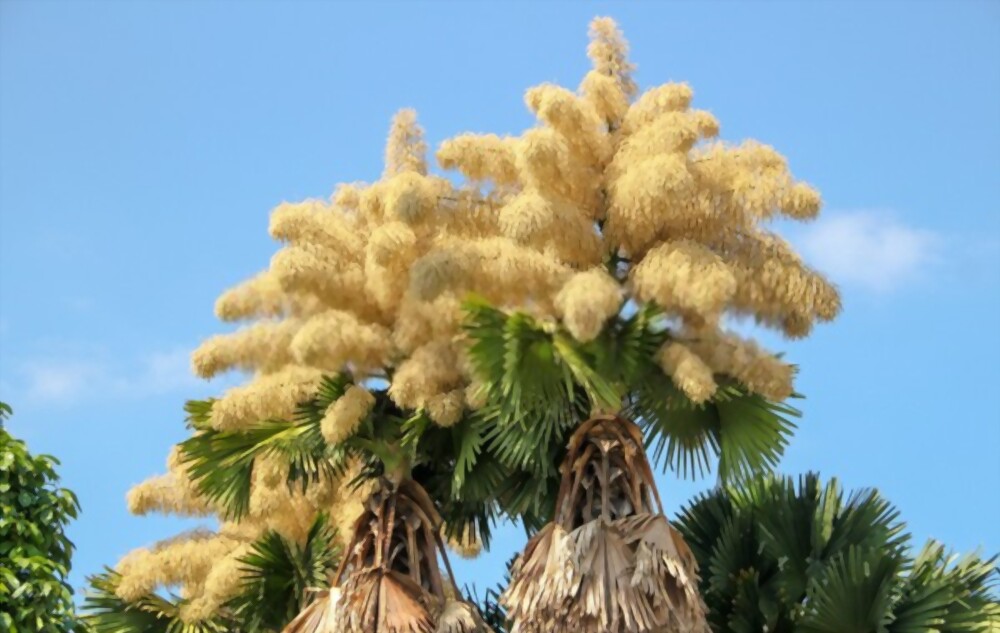Flowers have been beautifying the world’s landscape for thousands of years. Plants were able to make use of their flower’s subtle development, using scent and color to draw animals and insects for success in pollination. While there is a myriad of fragrant and gorgeous flowers that are found on the planet but the majority are similar in size and range from 1 – 5 inches in diameter. But in terms of the visibility of flowers, bright colors are crucial in attracting insects. The smell, too, is a key element in flower reproduction. Many flower species have a pleasant fragrance. However, this article will focus on identifying species of plants that have a distinct advantage due to size. These are the top 10 most beautiful flowers that are found in the world.
10. Lotus

Lotus is among the most well-known and revered flowers all over the world. The lotus flower isn’t just beautiful but also has immense spiritual and social importance. In India, the lotus flower is considered to be the national flower and is extensively utilized in sacred ceremonies. The flowers’ color plays an important role when it comes to significance. The Nelumbo family’s white and lotus pink flowers are sacred and symbolize the purity of life as well as devotion. On the contrary, vibrantly colored red, purple, and blue lotus flowers represent the Renaissance, illumination, as well as spiritual awakening. Lotus flowers thrive in muddy and shallow water and require sunshine to flourish. However they are not able to withstand cold climates, so they are not suitable for winter. This aquatic flower’s roots are stuck in the mud that lies at the bottom of still waters. Its small twigs rise to the surface of the water while the water-resistant leaves are sat over or just over the surface of the water’s surface. When fully mature the lotus flower’s petals that are higher than the surface of the water, could extend around 20 millimeters (7 inches). Its elegance is unmatched and can bring an air of calm and elegance to any setting. Many believe that the lotus’s distinctive aesthetics and significance make it a wonderful choice for any event.
9. Magnolia

One of the largest flowering plants, it is believed by a lot of researchers and scientists, can also be one of the one of the largest flowering plants to be found on the planet.
Fossils prove that they’ve existed present on Earth for a period of around 100 million years based on studies conducted by scientists. Since magnolia is so ancient the flowers do not have actual petals or sepals, they are tepals that resemble petals instead. The flowers don’t produce nectar however they attract pollinating beetles by their fragrant intoxicating secretions. Magnolia flowers are available in different shapes sizes, shapes, and colors. The magnolia family includes tall and fluffy trees, with pink white, red, purple, and yellow blossoms. Most magnolia species have large bulbs that measure between 6 and 8 inches in size.
Also More: 10 Intensely Fragrant Roses To Plant In Your Garden
8. Hibiscus

Hibiscus, also known as Hibiscus Sabdariffais one of the largest flowers.
These stunning bright flowers will surely enhance a backyard or house, but can also be used to treat.
We can find Hibiscus in different shades, including yellow, red white, peach, and red.
Sizewise, Hibiscus can grow as large as 8 inches wide.
The hibiscus family includes a variety of flowers ranging from annuals to perennials as well as plants known for their massive and bold blooms, which are often larger than an entire plate.
7. Peony tree

Common peonies are stunning flowers, however, their bigger cousin which is called the tree peony is quite different from the common peony.
Tree peonies are trees that lack support as they can only be taller than 10 feet.
They have many varieties, colors, and scents. Their flowers are larger and usually bloom two weeks before the herby peonies.
Chinese use them to decorate their homes and to serve medicinal reasons.
6. Common Sunflower

Sunflowers come native to North as well as South America, and some species are grown on farms to show the stunning size of their blooms as well as for the edible seeds (to create sunflower oil or to be directly eaten roasted). At a minimum, 6-8 hours of sunlight every day is required for sunflowers, and the more beneficial if you attempt to maximize their potential size. The massive blooming of sunflowers can be difficult to top. On tall stems, they can be found in Russian varieties of open flowers that measure that can reach 14 inches across and 9-12 feet high. Farmers tend to plant seeds in the spring, and they harvest their crops at the time of the summer. If you are looking for a practical use it is believed that the sunflower is the largest flowering plant in the world.
5. Puya raimondii

Puya raimondii can be described as the biggest bromeliad, reaching an average height of 15 meters, and is often referred to for being the Queen of the Andes. We can see this kind of plant throughout Bolivian as well as Peruvian forests at the top of the Andes. The flower can grow to the height of thirty feet (9.14 m) and is home to 8-12 million seeds in a plant. The Queen of the Andes in the wild contains the smallest of populations. There are many species that make up the bromeliad family, however, Puya raimondii is the least genetic diversity. Puya Raimondi is currently on the brink of extinction due to its inability to adapt to the changing climate and deforestation.
See More: Top 9 Most Beautiful Flowers For Hanging Baskets
4. Neptune grass (Posidonia oceanica)

Scientists have studied the Posidonia oceanica which is also known as “Neptune grass” to be about 200,000 years old and covers the ocean floor from Spain to Cyprus.
The plant includes twigs, roots, leaves, and flowers and produces fruits that are called sea olives.
It should not be mistaken for algae. It blooms in the season of autumn.
The leaves are tape-shaped, ranging from 1 centimeters in width as well as between 30 to 120 centimeters.
This aquatic plant grows throughout the Mediterranean Sea and certain areas south of Australia with characteristics similar that dryland.
Among the many advantages that are possessed by Neptune Grass is the fact that it helps to oxidize the oceans. It is also a source of food for numerous animals.
Its appearance also indicates that it’s of good quality and well-stored. Biologists frequently refer to Posidonia oceanica to be “Mediterranean’s lung..”
3. Talipot palm

Talipot palm is among the largest palms in the world, with its roots in the south of India. It can reach heights that can reach 25 m and a stem diameter that can reach 1.3 m. It is a palm fan that has a diameter of as high as 5 meters with a petiole that can reach up to 4 meters and more than 130 leaflets. The Talipot Palm has one or more than a million tiny flowers that are the biggest inflorescence of any plant. It is 6-8 meters long, arranged on an elongated trunk that is stitched over the trunk. The Talipot palms are monocarpic meaning they bloom only once between the ages between 30 and 80. Talipot Palm has many uses it’s just as useful as coconuts in its native region. Talipot fruit can be quite tasty and is referred to as ice apples.
2. Titan arum

Titan Arum also known in the form of Amorphophallus titanum or death flower is a unique flowering plant, with the largest flowering inflorescence that is not branched anywhere in the world. But, it’s not among the most fragrant flowers as it emits an odor that is similar to that of a decaying corpse when the plant is blooming. The plant itself can attain a height of about 10 – 15 feet with leaves that can reach 13 feet. The bloom of the Titan Arum isn’t like that of the talipot palm, however it instead, it branches out, making it a more substantial flower. The largest recorded flower of the corpse flower as per the Guinness Book of World Records was 10 feet 2.225 inches high which makes the Titan arum the largest bloom in the world. Despite its importance, it can be classified as “vulnerable” in the Red List of Threatened Plants by the International Union for the Conservation of Nature (IUCN). If the conditions that impact its existence and reproduction don’t alter, the plant could be endangered in the future, which could result in habitat loss and destruction being the most significant dangers.
1. Rafflesia Arnoldii

Rafflesia arnoldii is the largest flowering plant in the world which has a diameter of more than three feet. It is also known as Rafflesia transudate or Stinking corpse lily or corpse flower and is one of the largest living organisms. This parasitic plant is steady, not visible until it is about to bloom, with no roots, stems, twigs, or leaves. Buds arise over months to the size of the cabbage without a sign of the contaminated host plant. Corpse flowers bloom too, has a rotten corpse smell (more intense than Titan arum). While the flies gain nothing from the flowers, the pollen sticks to their back as they rest on the bloom, attracted by its rotten meat scent. When these flies pass into a female flora, the pollen is released in the flowers so they can fertilize it. Its produced fruit has thousands of seeds and is fleshy and small. Such fruits are consumed by tree shrews, which then continue to disperse the plant’s seeds (by excretion). Since Rafflesia is a unisexual plant and an uncommon one, flies sitting on a male’s bloom and bringing pollen from that flower have low chances of sitting on a female bloom and passing pollen into the female for fertilization. Rafflesia arnoldii is one of the world’s most endangered plant species. The International Union for the Conservation of Nature (IUCN) classifies certain Rafflesian species, such as Rafflesia Magnifica, as “critically endangered.”Rafflesia’s two primary factors contributing to the extinction of these species are the limited geographic area of this species and deforestation.


GIPHY App Key not set. Please check settings